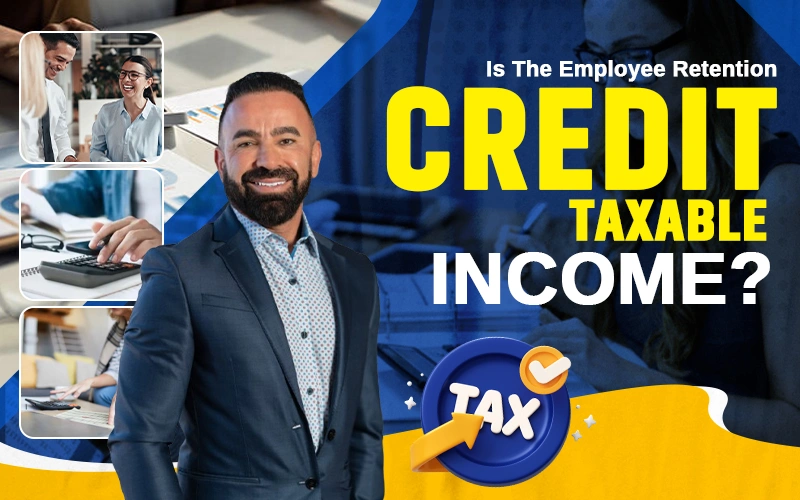
When considered from a cash flow perspective, receiving the ERC sounds ideal. Unfortunately, headaches start to occur when filing taxes post-receipt of the ERC. Is the employee retention credit taxable income? Technically, the answer is “no,” but it does change your payroll deductions, affecting your taxable profits.
How Does ERC Affect Tax Returns
There are three factors or questions that dictate how much the ERC (employee retention credit) will affect your tax returns.
- How much did you claim under the credit?
- How much payroll expense deductions did you take throughout the year?
- What type of business entity do you run?
The only way to answer these questions is to understand the relationship between the ERC and “taxable income.”
Is ERC Taxable Income
Our CPA in Los Angeles explains that the ERC is technically non-taxable income, but it will affect your payroll deductions. As the owner of a business or an employer who receives the employee retention credit, you must cut down your payroll expense deduction by the amount of the ERC claimed.
Let’s make this a bit simpler for you by unraveling the law surrounding employment credits.
Under IRC Section 280C, taxpayers need to reduce their deductible expenses by the amount of the R&D credit for the tax years that the credit has been taken.
R&D tax credits and ERC tax credits are two individual categories, and the IRS has stated that any credits claimed under the ERC cannot be claimed under R&D and vice versa. This rule prevents a business from “double-dipping.”
If you want your business to have better cash flow, you must take specific steps when claiming both federal tax credits.
Payroll deductions are basically wages withheld from the total taxable earnings to pay taxes and benefits.
So, when you claim ERC, you will effectively increase the amount of taxable income. In doing so, you will also add to the overall amount of taxes owed.
Reporting ERC On a Tax Return
The ERC is reported on the tax return on various forms based on the type of business you run, namely a partnership, cooperative, S-corporation, estate, or trust.
For example, if you are a corporation or, more specifically, an S-corporation, and you are a shareholder, then you will have to fill out the Form 1120-S. On the Form 1120-S, line 13g is the section used to report the income, gains, losses, deductions, and credits that go into calculating a business’s income tax liability.
Conversely, if you are a partner of a partnership, whether that be a general partnership, limited liability partnership, or a limited partnership, you will have to fill out Form 1065.
Apart from these forms, you will have to fill out an accompaniment form called Schedule K-1, which will vary in its informational requirements depending, again, on the type of business you run.
Finally, if you are a partnership, cooperative, S-corporation, estate, or trust, you must file the Form 5884-A for any employee retention credit claims.
Choose the Right CPA Firm for Your Business
Partner with Jarrar & Associates for expert tax, accounting, and financial guidance tailored to your needs—so you can focus on growth.
How to Report ERC on Tax Return 1120-S
The process of reporting ERC is quite straightforward but it is crucial to scrutinize and ensure the proper fields are completed. The following section discusses the forms mentioned above and their relevant sections.
Form 1120-S
Form 1120-S is the tax return that S-corporations file to report income, losses, credits, and deductions. It essentially shows the IRS how much money the business made or lost during the year and passes that information on to its shareholders.
An S-corporation is a business type that avoids “double taxation.” Instead of the company paying taxes on its income, that responsibility is passed to the individual shareholders, who report their share on their personal tax returns.
This form is due by the 15th day of the third month after the end of the S-corp’s tax year—usually March 15 if the year ends in December.
Line 13g
Line 13g on Form 1120-S is where you report “Other Credits” that don’t fit neatly into the earlier sections. These can include:
- Undistributed capital gains credits: These come from taxes already paid by investment or real estate trusts. Since the IRS considers those taxes as being paid by the shareholders, they get a credit in return.
- Work opportunity credit: This credit rewards businesses for hiring people from certain groups that often face job-related challenges—like veterans, ex-felons, or long-term unemployed individuals.
- Social Security and Medicare tax credit: Mostly relevant to restaurants or bars, this credit applies when employers pay tax on the tips their employees earn.
- Backup withholdings: If your business withholds taxes on payments like interest or dividends, those get reported here.
- Code P / Other credits: Any credits that don’t have a specific box go under Code P. One key example here is the employee retention credit, which must also be reported on a separate form—Form 5884.
Form 5884-A
Form 5884-A lets certain businesses claim the employee retention credit if they were affected by a qualified disaster. This includes partnerships, S-corps, trusts, and more.
To qualify, you need to have continued paying your employees even if your business couldn’t operate because of disaster-related damage. You can claim 40% of up to $6,000 in wages per employee, which means a credit of up to $2,400 each.
Schedule K-1
Schedule K-1 breaks down each shareholder’s or partner’s share of the business’s income, losses, credits, and other financials. If you’re part of a partnership or an S-corporation, you’ll get one of these each year.
Each person uses the info from their K-1 to fill out their own tax return. It’s a detailed form that includes everything from regular income to international transactions and even non-deductible expenses.
There are a few versions of Schedule K-1. Partnerships use the one that goes with Form 1065, while S-corporations file theirs along with Form 1120-S, which we talked about earlier.
Reporting ERC on Form 1065 (Schedule K-1 for Partnerships)
Form 1065 is what partnerships use to report their income and expenses. Since partnerships are made up of two or more people, each partner gets their own Schedule K-1 showing their individual share.
Let’s say the partnership earned $500,000 in 2023. If there are two partners, each one would get a K-1 showing $250,000 of income.
Here’s how to report the employee retention credit (ERC) on Form 1065:
Step 1: Fill out the main Form 1065
List your share of profits, losses, and deductions. Keep in mind, each partner is responsible for applying any limits to losses or credits.
Recent updates to the form (thanks to the Inflation Reduction Act) added new items like energy tax credits, incentives for biofuels, and even payroll tax credits for COVID-related sick leave. But don’t worry—ERC still needs to be claimed separately.
Step 2: Go to Box 15 – “Credits”
Box 15 is where you list various credits. Look for the entry titled “Employee retention credit for employers affected by qualified disasters.”
Step 3: Report the ERC accurately
List the amount of ERC your business qualifies for. Just make sure you don’t double-count it—you’ll need to reduce your payroll deduction by the credit amount.
Closing Statements
In the end, as a fully refundable tax credit, the ERC is neither a loan nor something that must be repaid. The refundable credit is “in excess” of the taxes from payroll generated within the credit period.
Nevertheless, it is incredibly important to accurately record the amount and calculate the amount of payroll expense deduction claimed, such that it is accurate given the amount of credit claimed.
Every type of business entity comes with its own form, whether it is Form 1120-S for the S-corporation or Form 1065 for the partnership. That’s why it’s crucial to keep track of the forms submitted and consult us for all types of tax services Los Angeles, CA if you need assistance with your ERC affairs.
Also Read: What Exactly Does a Bookkeeper Do?
FAQs
Can you amend a prior year’s return to claim the ERC?
Yes, you can amend prior payroll tax filings to claim the ERC retroactively by submitting Form 941-X. You generally have up to three years to do so.
Can you claim both PPP and ERC?
Yes, you can claim both, but not on the same wages. Any wages used for PPP loan forgiveness cannot also be used to claim the ERC credit.
What payroll expenses are eligible for ERC?
Qualified payroll expenses include wages paid to employees during eligible quarters, along with employer-paid health plan costs. These must not overlap with PPP-covered wages or other credits.
Does receiving ERC delay your tax refund?
It can. Claiming ERC via amended returns or credit adjustments may slow down your overall IRS processing time, especially if you’re waiting for a refund or credit allocation.
Do sole proprietors qualify for the ERC?
No, sole proprietors with no employees do not qualify. The ERC is only for employers who paid qualifying wages to actual employees, not to the business owner themselves.



